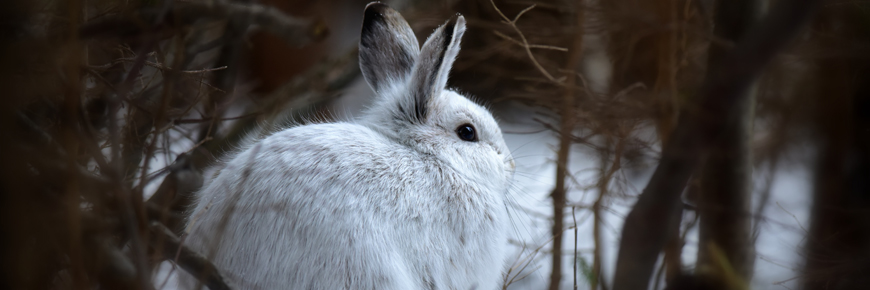
Snowshoe hare
Cape Breton Highlands National Park
The snowshoe hare is a small hare distinguished by its large hind feet and black-tipped ears. The snowshoe hare sheds completely twice a year, changing its coat to dark brown in the spring and to white in the fall. It eats succulent vegetation in the summer and in the winter it eats twigs, buds, and bark. The female can bear 2 to 3 litters of 2 to 4 young each year between April and August. Few hares live more than 3 years in the wild.
Distribution
The snowshoe hare can be found in all of Canada except the most northern parts, in Alaska and the northern United States and can be found as far south as northern California and North Carolina in mountainous areas.
Hares as prey
Snowshoe hares are food for many other species of animals, including red fox, coyote, bobcat and hawks but they are especially important for lynx and great horned owls.
Snowshoe hare populations exhibit a cycle, usually spanning about 11 years, in which their numbers gradually increase until their population is very dense. The cycle then crashes suddenly. The crash can happen simultaneously across all of Canada and Alaska within one or two years. Scientists are not yet certain what causes the crash—it may have something to do with sunspot cycles and the effect they have on weather patterns and forest fires. It may have something to do with disease, lack of food or predation. It is probably a combination of many factors, some of which may not yet be known.
The lynx has evolved to predate most heavily on snowshoe hare although it does eat other animals as well. The lynx population is so closely intertwined with the hare population that its cycle follows the hare cycle. As snowshoe hare numbers increase, lynx numbers also rise because of increased access to food which improves birth and survival rates. When the snowshoe hare population crashes, the lynx's main food source is gone so its reproduction and survival rates also drop.
Great horned owls also seem to rely heavily upon the snowshoe hare. Occasionally, large winter migrations of great horned owls to the southern extremities of their range have been observed. These migrations seem to coincide with the crash in the snowshoe hare cycle. It is believed that the owls move further south in order to find enough food to survive the winter.
The effects of the population crash don't stop here. When there are practically no hares to eat, predators must turn to other sources of food, which means other animals get preyed upon more often. The effects of the snowshoe hare cycle are felt throughout the entire ecosystem.
Related links
- Date modified :